|
Ziegler's Grove
Battle of Gettysburg
Ziegler's Grove Battle of Gettysburg Cemetery Ridge Seminary
Ridge Pickett’s Charge Emmitsburg Road Map, General Hays Division Casualties, General Pettigrew, General Pickett,
Trimble, Rhodes, East Cemetery Hill Maps, Photo, Photos, History, Details
Ziegler's Grove and Battle of Gettysburg
Introduction
Ziegler’s Grove, a prominent feature on Cemetery Ridge, was the location
of fierce fighting on the 2nd and 3rd days of the Battle of Gettysburg (July 2-3, 1863).
Elements of the two armies collided west and north of the town on July 1,
1863. Union cavalry under Brig. Gen. John Buford slowed the Confederate advance until Union infantry, the Union 1st and 11th
Corps, arrived. More Confederate reinforcements under generals A.P. Hill and Richard Ewell reached the scene, however, and
30,000 Confederates ultimately defeated 20,000 Federals, who fell back through Gettysburg to the hills (Cemetery Hill and
Culp's Hill) south of town.
On the second day of battle, the Union defended a fishhook-shaped range
of hills and ridges south of Gettysburg with around 90,000 soldiers. Confederates essentially wrapped around the Union position
with 70,000 soldiers. On the afternoon of July 2, Lee launched a heavy assault on the Union left flank, and fierce fighting
raged at Devil's Den, Little Round Top, the Wheatfield, the Peach Orchard and Cemetery Ridge. On the Union right, demonstrations
escalated into full-scale assaults on Culp's Hill and East Cemetery Hill. Although the Confederates gained ground, the Union
defenders still held strong positions by the end of the day.
On July 3, fighting resumed on Culp's Hill, and cavalry battles raged to
the east and south, but the main event was a dramatic infantry assault by 12,000 Confederates, known as Pickett's Charge,
against the center of the Union line on Cemetery Ridge. The charge was repulsed by Union rifle and artillery fire, at great
losses to the Confederate army. Lee led his army on a torturous retreat back to Virginia. As many as 51,000 soldiers from
both armies were killed, wounded, captured or missing in the three-day battle.
| Ziegler's Grove, Gettysburg |
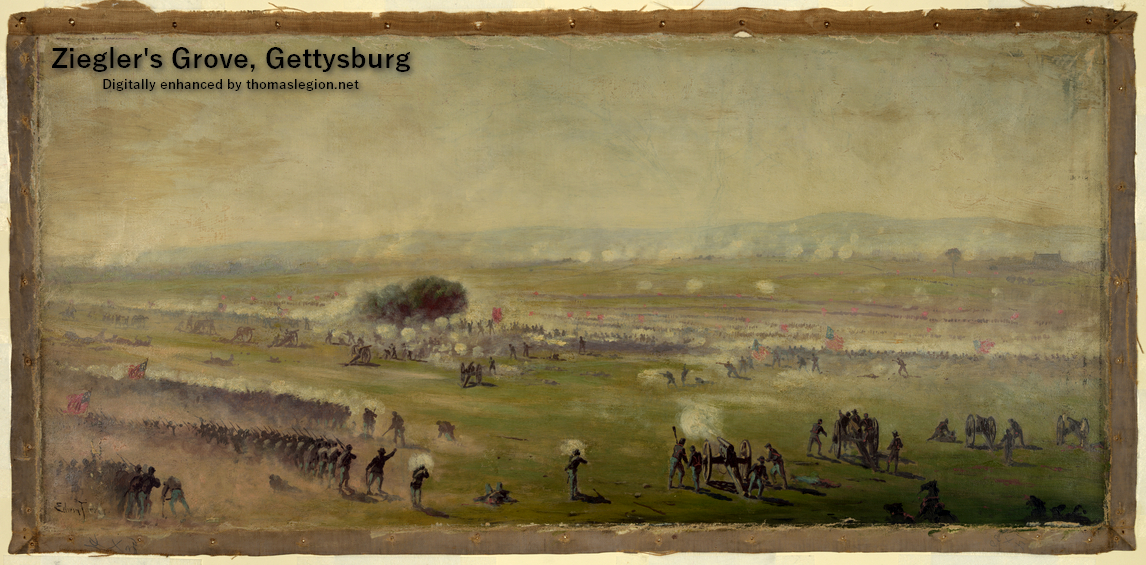
|
| Ziegler's Grove during Pickett's Charge |
(About) Pickett's Charge from the Confederate position, with
Ziegler's Grove on the left and the copse of trees on right. By Edwin Forbes. Library of Congress.
| Ziegler's Grove |
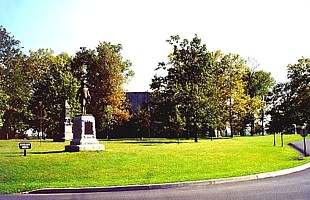
|
| Ziegler's Grove, Gettysburg |
History
This small grove of oak, hickory and chestnut trees on the northern end
of Cemetery Ridge marked the general positions held by General Alexander Hays' Division
of the Union Second Corps. Adjacent to the grove is the Brian farm and farm buildings, including the small farm house used
by General Hays for his headquarters. Artillerymen had set up their guns at the edge of the woods, which also provided
shade from the warm afternoon sun. The grove was the only tall stand of trees on this portion of Cemetery Ridge which turned
sharply eastward at this point to join into Cemetery Hill. Hays' men, with several regiments of the First Army Corps nearby, enjoyed a clear field of fire in three directions
from this location and his skirmish line had successfully kept General Robert Rodes' division at bay during the second day
of the battle and again on the morning of the 3rd.

Stretching southward from Ziegler's Grove was a line of stone walls that provided
natural protection for the infantry regiments here and Hays' men used these strong walls for defensive positions. Rails that
added height to the walls were taken down and piled on top of the stones to add height for the men kneeling and standing behind
them. During Pickett's Charge, the wall south of the Brian barn bristled with infantrymen who fired down at
the Confederates crossing the Emmitsburg Road, approximately 200 feet away.
(Left) Picture of the stone wall on Cemetery Ridge behind which General
Hays posted two brigades of his division. Gettysburg NMP.
The Confederates who struck this portion of Cemetery Ridge were under the
command of Brigadier General James Johnston Pettigrew and Major General Isaac Trimble. Halted by heavy musketry from Hays'
line, the Southerners also suffered cannon fire from Union batteries on west Cemetery Hill and in Ziegler's Grove. Though
many soldiers halted in the road to return fire, others followed their flag bearers over the fences and continued towards
the stone wall. Soldiers fell by the dozens, but the flags continued forward.
General Pettigrew had just conferred with General Trimble near the road when both were severely
wounded, Pettigrew in the hand and Trimble in the leg; no supports could be seen coming to their aid. A lone Union regiment,
the 8th Ohio Infantry, swung into the Southern left flank, sending deadly rifle fire down the road and hitting the crouching Confederates.
The Confederate flags disappeared, fallen into the smoke, not rising again as bearers and supporters were killed or wounded.
There was nothing left for the painfully wounded Pettigrew to do but order a retreat.
| Battle of Gettysburg High Definition Map |
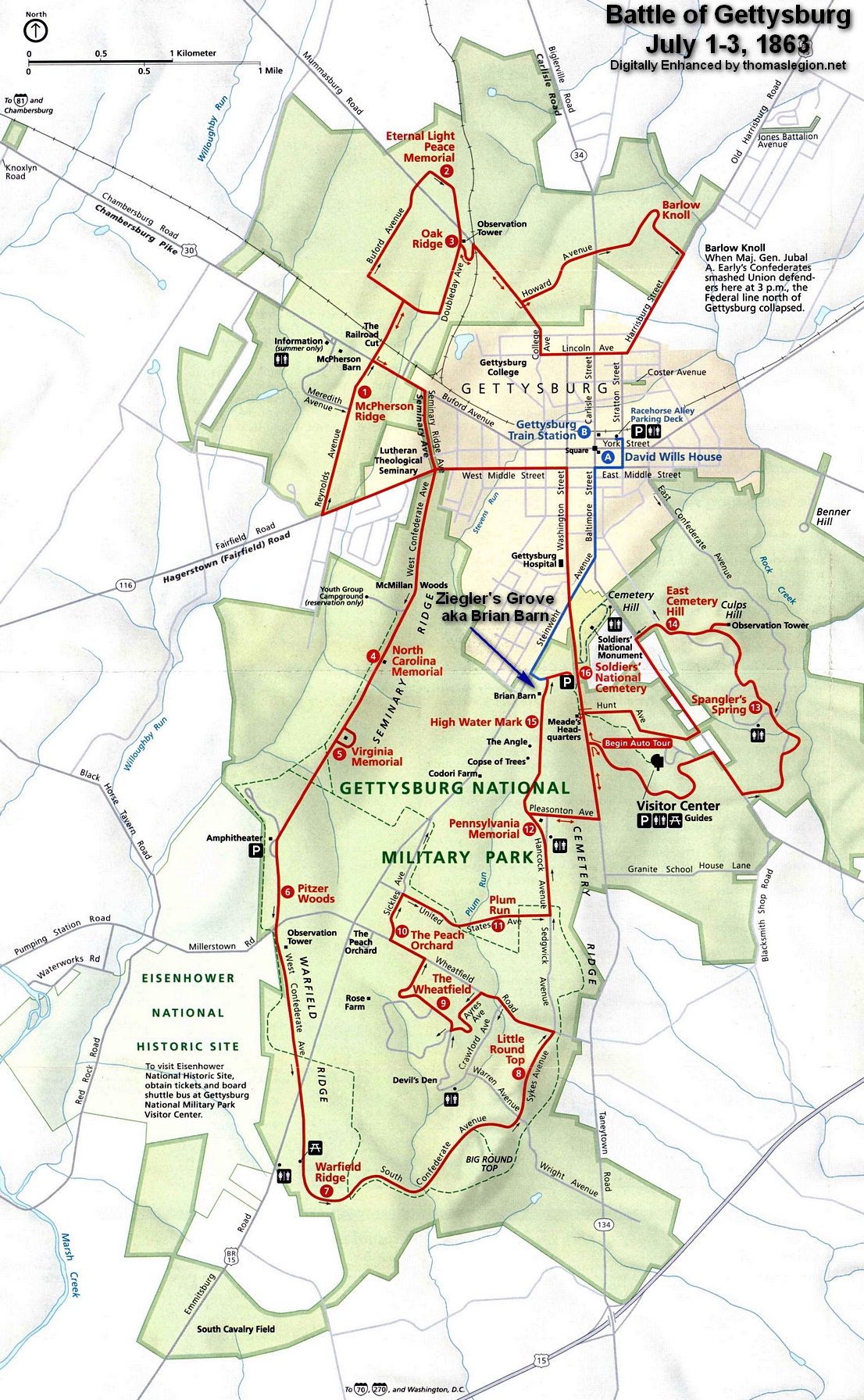
|
| Ziegler's Grove, Battle of Gettysburg Map |
| Gettysburg Civil War Battlefield Map |
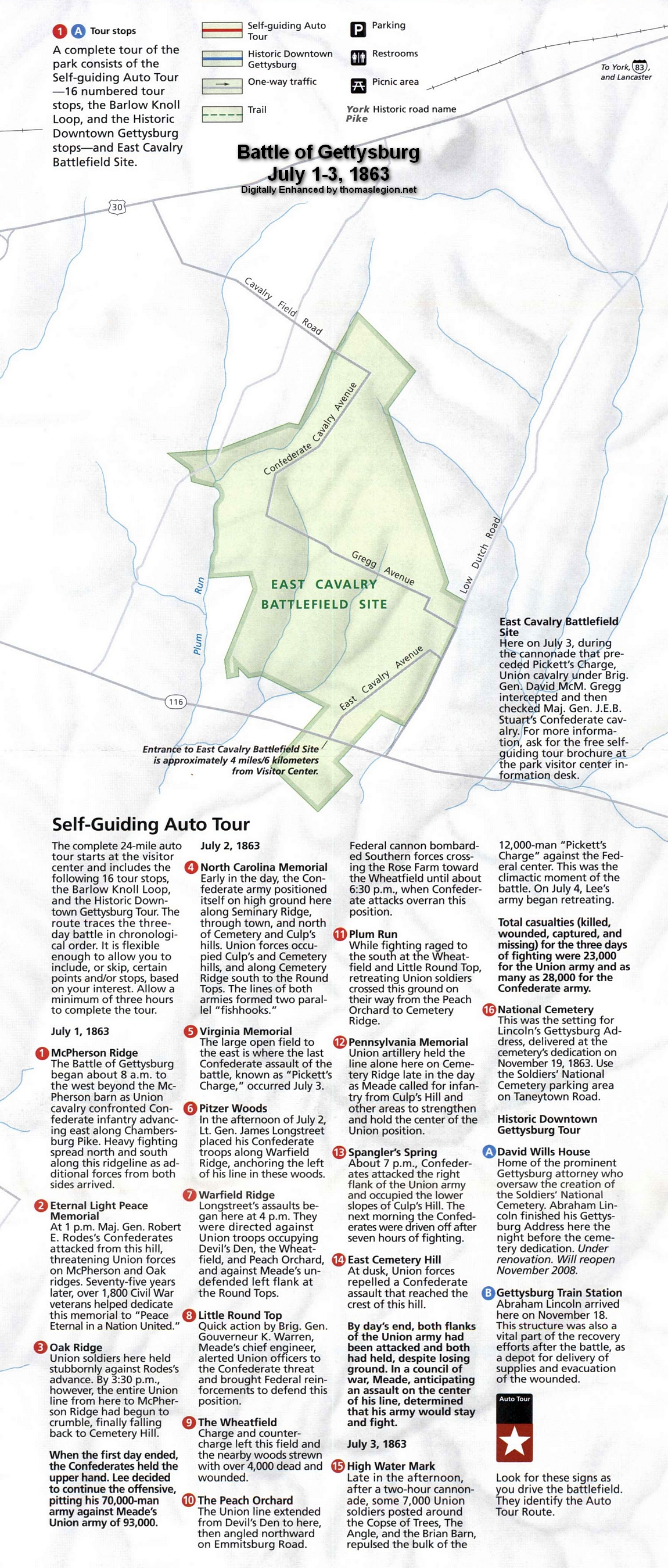
|
| Battle of Gettysburg Map |
| Hays Monument |
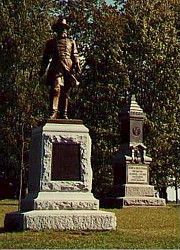
|
| General Hays Monumen |
Just as the last few shots echoed over the hills, General Meade arrived on the scene behind Hays' line. Seeing the Confederates in retreat, the general waved his hat and shouted a hoarse
"Hurrah!" as a Union band struck up "The Battle Cry of Freedom". General Meade knew that his army had given Lee a telling
blow, but his had also suffered severely during the battle. Satisfied with the day's results, Meade decided to hold his commanding
position and wait for Lee's next move. Apart from a skirmish on the southern flank of both armies, the Battle of Gettysburg had drawn to a bloody close.
General Hays encouraged his soldiers throughout the battle, his booming voice rising above the din. After
the Confederates had retreated, a captured Confederate flag (one of fifteen taken by his division) was brought to the general
by one of his men and the jubilant Hays dragged the banner through the dust in front of his division to the accompaniment
of hurrahs and lustful cheers.
To the soldiers of his division that had been humiliated by their surrender to "Stonewall" Jackson at Harper's Ferry in 1862, their part in the repulse of Pickett's Charge restored the honor many felt had
been lost.
| Gen. Hays |

|
| (U.S.A.M.H.I.) |
Gettysburg was a high point for General Hays' military career. After reorganization and consolidation of
forces within the Army of the Potomac the following year, Hays was re-assigned to command a brigade in the Second Corps. Accompanying his good friend
and commander of all Union armies, General Ulysses S. Grant, General Hays led his brigade into the opening of the Wilderness
Campaign in 1864 and was killed at the Battle of the Wilderness on May 5th. Posthumously awarded the rank of brevet major general on the day he died, Hays' remains were
taken to Pittsburg where he was buried. A monument in his honor now stands in Ziegler's Grove. Erected in 1915, the
sword wielding bronze likeness of the general overlooks the fields of Pickett's Charge.
| The Bloody Angle |
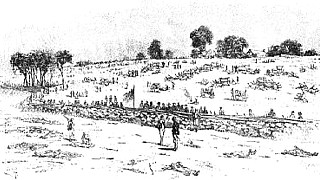
|
| The Bloody Angle, Gettysburg |
(Left) Picture of the "Angle" and clump of trees after Pickett's Charge, drawn by Edwin Forbes. Battles
& Leaders.
Squads collected over 2,500 discarded rifles and thousands of sets of accoutrements from the field in front
of the Second Corps. The grisly job of burying the dead was also left up to the Union soldiers who buried their own before
turning their attention to the hundreds of Confederate bodies lying in front of the stone wall. The remains of 1,242 Southerners
were buried along the Second Corps front in long trench graves, among them the body of a female dressed in Confederate uniform.
The shocking discovery led to speculation that the young woman had followed her husband into Confederate service dressed as
a male to hide her gender, though her true identity forever remains a mystery.
The fields where Pettigrew's and Trimble's commands marched have changed
very little except for the encroachment of modern homes in the borough of Gettysburg to the edge of the historic Bliss Farm.
In 1913, the Great Camp was set up adjacent to the area for "The Great Anniversary and Reunion of 1913." In 1917, "Camp Colt" was established on this site and was the first US Army camp authorized to train the fledgling
army Tank Corps during World War I. Captain Dwight D. Eisenhower commanded Camp Colt. All traces of this historic camp are
gone except for a commemorative tree and marker planted adjacent to the Emmitsburg Road on the general location of the camp.
Another war brought another US Army camp, yet for a very different purpose. A temporary compound that held 300 German prisoners
of war stood in the field on the west side of the Emmitsburg Road for approximately six months in 1944. The German prisoners
were used as labor to pick and process fruit, cut and mill lumber, and make road and trail improvements in Adams County. Like
Camp Colt, all traces of this camp are long gone, the fields having returned to their more peaceful use in agriculture.
"The University Greys"
| 11th Mississippi Infantry Marker |
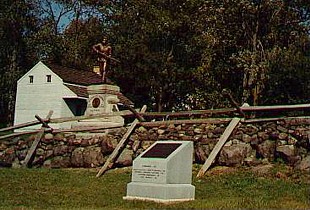
|
| Marker to The 11th Mississippi Infantry |
Thankfully, one company of the 11th Mississippi Infantry Regiment was spared during the first day of
battle; however, it was not so lucky that fateful afternoon. In 1861, approximately 110 students at the University of Mississippi
left the classroom to enlist in the army and were accepted by the state as Company A of the 11th regiment. "Impulsive and
undisciplined", the new soldiers were slow to follow military discipline but were always ready to be "in the front" of a battle.
Only 31 members of the Greys stood in the ranks on July 3 and set out behind the colors of the 11th to drive through a supposedly "shattered Yankee line." Instead, the
company was whittled down by Union cannon fire. "Pressing onward," Lt. William Peel recalled, "our line was melting away with
alarming rapidity... reduced to a mere skeleton. Still, on it pushed, with a determination that must ever be a credit to the
Confederate soldier."
Eight color bearers of the 11th were shot down before the flag staff was cut in two by a minie ball. A small
handful of Mississippians crowded behind the flag and made their way to the Brian Barn where the bullets flew thick and fast.
Within minutes it was over. A handful of the 11th escaped through a gauntlet of fire to Seminary Ridge. Of the 394 officers and men that began the charge, only 53 answered the roll call that night. No
one answered from the University Greys. Every last one of those former students had been killed or wounded in the great charge
at Gettysburg.
The Brian Farm
| Brian's Farm House |
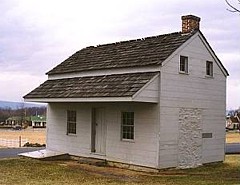
|
| Abraham Brian's Farm House |
Abraham Brian (Bryan) was a free black man who resided in Adams County prior to purchasing this twelve acre
farm on Cemetery Ridge in 1857. Brian had been left a widower with five children to support; then he married for a third time.
With his wife Elizabeth, the two moved their large family into a small farmhouse adjacent to Ziegler's Grove where he evidently
felt he could better provide for his family as a farmer. Brian kept a horse and a cow and planted wheat, barley, and hay in
his small fields. He also groomed a plentiful apple and peach orchard adjacent to his house.
This quiet farm life was shattered during the first three days of July 1863.
The arrival of Union troops on his doorstep late on the evening of July 1st, hastened Brian to gather his family and leave.
He returned after the battle to find his home ransacked, walls filled with bullet and shell holes, windows smashed, and furniture
dragged into the yard. Fences were destroyed, crops trampled and the orchard trees ruined. The pasture west of the barn was
a huge graveyard. Brian could do little but attempt to repair the extensive damage and rebuild his life. He continued to farm
the land until 1869 when he moved into Gettysburg and took up work at a hotel. Some years later, Brian filed a claim for damages
to his property totaling $1,028. Unlike most claimants, Brian was compensated a mere $15. He died in 1875 and is buried in
Gettysburg next to his first two wives.
Very little is known about Abraham Brian today though his farm remains part
of one the most historical sites in the United States. A reconstructed house and barn are mute testimony to the shattering
effect the battle had on Mr. Brian and other Adams County civilians.
Sources: Gettysburg National Military Park; National Archives; Official Records of the Union and Confederate
Armies; Library of Congress.
Recommended Reading: Gettysburg--The First Day,
by Harry W. Pfanz (Civil War America)
(Hardcover). Description: Though a great deal has been
written about the battle of Gettysburg, much of it has focused
on the events of the second and third days. With this book, the first day's fighting finally receives its due. Harry Pfanz,
a former historian at Gettysburg National
Military Park and author of
two previous books on the battle, presents a deeply researched, definitive account of the events of July 1, 1863. Continued below…
After sketching the background
of the Gettysburg
campaign and recounting the events immediately preceding the battle, Pfanz offers a detailed tactical description of the first
day's fighting. He describes the engagements in McPherson Woods, at the Railroad Cuts, on Oak
Ridge, on Seminary Ridge, and at Blocher's Knoll, as well as the retreat of Union forces through Gettysburg and the Federal rally on Cemetery Hill. Throughout, he draws on
deep research in published and archival sources to challenge some of the common assumptions about the battle--for example,
that Richard Ewell's failure to press an attack against Union troops at Cemetery Hill late on the first day ultimately cost
the Confederacy the battle.
Recommended Reading: Gettysburg--The Second Day, by Harry W. Pfanz (624
pages). Description: The second day's fighting at Gettysburg—the assault of the Army
of Northern Virginia against the Army of the Potomac on 2 July 1863—was probably the
critical engagement of that decisive battle and, therefore, among the most significant actions of the Civil War. Harry Pfanz,
a former historian at Gettysburg National
Military Park, has written a
definitive account of the second day's brutal combat. He begins by introducing the men and units that were to do battle, analyzing
the strategic intentions of Lee and Meade as commanders of the opposing armies, and describing the concentration of forces
in the area around Gettysburg. Continued below...
He then examines
the development of tactical plans and the deployment of troops for the approaching battle. But the emphasis is on the fighting
itself. Pfanz provides a thorough account of the Confederates' smashing assaults—at Devil's Den and Little Round Top,
through the Wheatfield and the Peach Orchard, and against the Union center at Cemetery Ridge. He also details the Union defense
that eventually succeeded in beating back these assaults, depriving Lee's gallant army of victory. Pfanz analyzes decisions
and events that have sparked debate for more than a century. In particular he discusses factors underlying the Meade-Sickles
controversy and the questions about Longstreet's delay in attacking the Union left. The narrative is also enhanced by thirteen superb maps, more than eighty illustrations,
brief portraits of the leading commanders, and observations on artillery, weapons, and tactics that will be of help even to
knowledgeable readers. Gettysburg—The Second Day
is certain to become a Civil War classic. What makes the work so authoritative is Pfanz's mastery of the Gettysburg literature and his unparalleled knowledge of the ground on which the fighting
occurred. His sources include the Official Records, regimental histories and personal reminiscences from soldiers North and
South, personal papers and diaries, newspaper files, and last—but assuredly not least—the Gettysburg battlefield.
Pfanz's career in the National Park Service included a ten-year assignment as a park historian at Gettysburg. Without doubt, he knows the terrain of the battle as well as he knows the battle
itself.
Recommended Reading: Gettysburg: A Testing of Courage. Description: America's Civil War raged for more than four years,
but it is the three days of fighting in the Pennsylvania
countryside in July 1863 that continues to fascinate, appall, and inspire new generations with its unparalleled saga of sacrifice
and courage. From Chancellorsville, where General Robert E. Lee launched his high-risk campaign into the North, to the Confederates'
last daring and ultimately-doomed act, forever known as Pickett's Charge, the battle of Gettysburg gave the Union army a victory
that turned back the boldest and perhaps greatest chance for a Southern nation. Continued below...
Now, acclaimed
historian Noah Andre Trudeau brings the most up-to-date research available to a brilliant, sweeping, and comprehensive history
of the battle of Gettysburg that sheds fresh light on virtually every aspect of it. Deftly balancing his own
narrative style with revealing firsthand accounts, Trudeau brings this engrossing human tale to life as never before.
Recommended Reading: The
Gettysburg Campaign: A Study in Command (928
pages). Description:
Coddington's research is one of the most thorough and detailed studies of the Gettysburg Campaign. Exhaustive in scope and
scale, Coddington delivers, with unrivaled research, in-depth battle descriptions and a complete history of the regiments
involved. This is a must read for anyone seriously interested in American history and
what transpired and shaped a nation on those pivotal days in July 1863.
Recommended Reading: Gettysburg,
by Stephen W. Sears (640 pages) (November 3, 2004). Description: Sears delivers another masterpiece with this comprehensive study of America’s most studied Civil War battle. Beginning with Lee's meeting with
Davis in May 1863, where he argued in favor of marching north, to take pressure off both Vicksburg and Confederate logistics. It ends with the battered Army
of Northern Virginia re-crossing the Potomac just two months later and with Meade unwilling to drive his equally battered
Army of the Potomac into a desperate pursuit. In between is the balanced, clear and detailed
story of how tens-of-thousands of men became casualties, and how Confederate independence on that battlefield was put forever
out of reach. The author is fair and balanced. Continued below...
He discusses
the shortcomings of Dan Sickles, who advanced against orders on the second day; Oliver Howard, whose Corps broke and was routed
on the first day; and Richard Ewell, who decided not to take Culp's Hill on the first night, when that might have been decisive.
Sears also makes a strong argument that Lee was not fully in control of his army on the march or in the battle, a view conceived
in his gripping narrative of Pickett's Charge, which makes many aspects of that nightmare much clearer than previous studies.
A must have for the Civil War buff and anyone remotely interested in American history.
Recommended Reading: The History
Buff's Guide to Gettysburg (Key People, Places, and Events)
(Key People, Places, and Events). Description: While most history books are dry monologues of people, places, events and dates, The History Buff's Guide is ingeniously
written and full of not only first-person accounts but crafty prose. For example, in introducing the major commanders, the
authors basically call Confederate Lt. Gen. Richard S. Ewell a chicken literally. 'Bald, bug-eyed, beak-nosed Dick Stoddard
Ewell had all the aesthetic charm of a flightless foul.' To balance things back out a few pages later, they say federal Maj.
Gen. George Gordon Meade looked like a 'brooding gargoyle with an intense cold stare, an image in perfect step with his nature.'
Continued below...
Although it's
called a guide to Gettysburg, in my opinion, it's an authoritative guide to the Civil War. Any history buff
or Civil War enthusiast or even that casual reader should pick it up.
Recommended Reading: The Maps of Gettysburg: The Gettysburg
Campaign, June 3 - July 13, 1863 (Hardcover). Description: More academic and photographic accounts on the battle of Gettysburg
exist than for all other battles of the Civil War combined-and for good reason. The three-days of maneuver, attack, and counterattack
consisted of literally scores of encounters, from corps-size actions to small unit engagements. Despite all its coverage,
Gettysburg remains one of the most complex and difficult to
understand battles of the war. Author Bradley Gottfried offers a unique approach to the study of this multifaceted engagement.
The Maps of Gettysburg plows new ground in the study of the campaign by breaking down the entire campaign in 140 detailed
original maps. These cartographic originals bore down to the regimental level, and offer Civil Warriors a unique and fascinating
approach to studying the always climactic battle of the war. Continued below...
The Maps of
Gettysburg offers thirty "action-sections" comprising the entire campaign. These include the march to and from the battlefield,
and virtually every significant event in between. Gottfried's original maps further enrich each "action-section." Keyed to
each piece of cartography is detailed text that includes hundreds of soldiers' quotes that make the Gettysburg
story come alive. This presentation allows readers to easily and quickly find a map and text on virtually any portion of the
campaign, from the great cavalry clash at Brandy Station on June 9, to the last Confederate withdrawal of troops across the
Potomac River on July 15, 1863. Serious students of the battle will appreciate the extensive
and authoritative endnotes. They will also want to bring the book along on their trips to the battlefield… Perfect for
the easy chair or for stomping the hallowed ground of Gettysburg,
The Maps of Gettysburg promises to be a seminal work that belongs on the bookshelf of every serious and casual student of
the battle.
|

